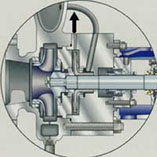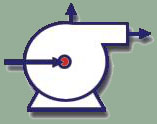 "Multiplicity ought not to be posited without necessity." — Occam's Razor Otherwise stated: |
Process Engineering AssessmentsSplit Flow provides cost-saving option to common process problemOne of the common design issues encountered in refining involves pumping a liquid to two dispositions where the smaller stream requires a considerably higher discharge pressure than the other stream. An example would be the overhead liquid on a naphtha splitter where liquid from the overhead receiver is used as reflux and is also pumped to a stabilizer that operates at pressures greater than the splitter. Current practice is to either install two pumps, i.e. a large volume, low-head pump for the reflux service and a low-volume, high-head pump for the product or export service; or install a single pump designed to pump all of the liquid to the higher discharge pressure and throttle the reflux stream. This wastes energy. Little Split Flow™ addresses the above issue. Several major API pump manufacturers now have two-impeller pumps where the second impeller, which takes it's suction from the primary impeller, is designed to do the following:
The second (auxiliary) impeller is on the same shaft as the first one and takes suction from the primary impeller. A standard API overhung pump assembly is modified to accommodate this feature. Potential benefits associated with Little Split Flow include significant decreases in project and operating costs and less equipment clutter in the process area. Our client’s interests may be better served if future design projects consider the Split Flow pump concept as an alternative for dual service applications. See schematic of criteria for use of Split Flow. 'The obvious often escapes us'We frequently encounter situations where a fluid is pumped from one source to two different destinations: One stream requiring high flow at low head, and the other stream requiring low flow at high head. A column with a forced-circulation reboiler and a small bottoms take-off is a classic example. Typically, a single pair of pumps to service the reboiler and provide bottoms take-off ends up being too large, too expensive, and thus inefficient. The alternative isn't necessarily much better: A dedicated pair of pumps for the reboiler circuit and a second pair for the bottoms take-off represents an addition of two items to the equipment list. We now have a third option: The Split Flow modified API centrifugal pump design separates the total flow into a primary high-flow, low-head discharge and a secondary low-flow, high-head discharge. This feature can be incorporated into any standard API horizontal or vertical inline pump regardless of size. |
Split Flow™
"Potential benefits associated with Little Split Flow include significant decreases in project and operating costs and less equipment clutter in the process area." |
